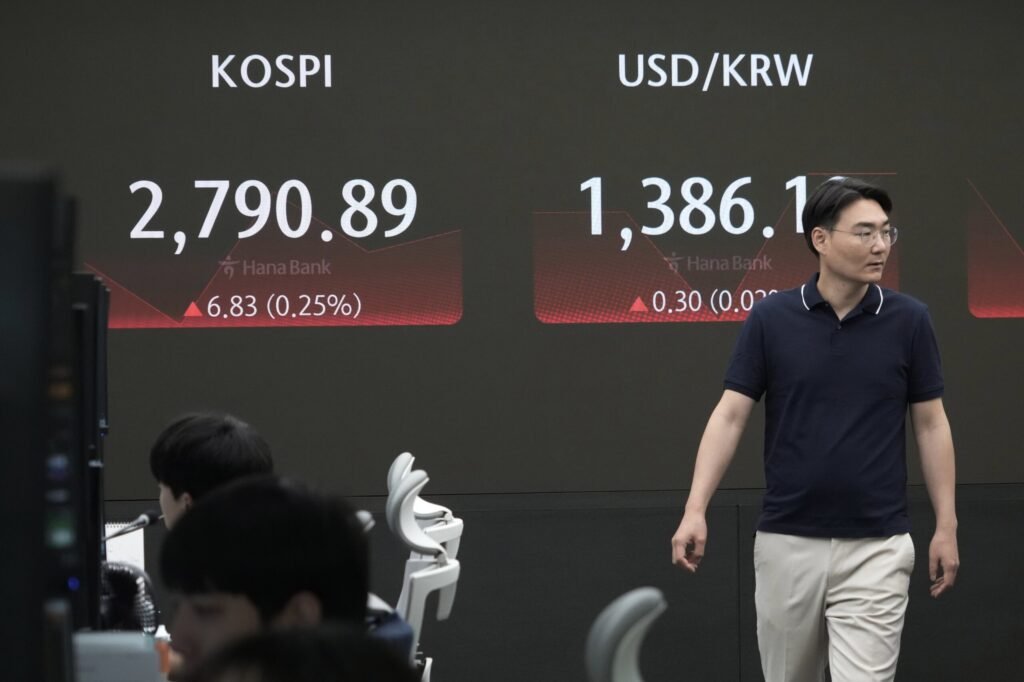Wall Street stocks gave up early gains and ended lower on Friday, ending a three-week rally for the S&P.
Wall Street stocks gave up early gains and closed lower on Friday, ending a three-week winning streak for the S&P 500.
A late sell-off pushed the benchmark indexes down 0.4%, ending the week lower. The Nasdaq Composite Index was down 0.7%, while the Dow Jones Industrial Average ended down 0.1%.
Despite the weak close, the S&P 500 and Nasdaq remain near all-time highs.
The market was weighed down by declines in big technology stocks, which have made big gains during the market’s record rally. Apple closed down 1.6%, Microsoft 1.3% and Meta Platforms 3%.
Ross Mayfield, investment strategy analyst at Baird, said the late afternoon surge in selling could reflect traders taking profits as the market approaches all-time highs or reshuffling portfolios at the end of the second quarter.
“I wouldn’t be surprised at all if we saw some profit-taking today, especially in stocks that have risen sharply,” Mayfield said. “That may be why big tech stocks are performing a little weaker relative to the overall market.”
Markets rallied early after a closely watched report showed inflation continuing to ease, with investors hoping that abatement will prompt the Federal Reserve to start cutting interest rates, which are at their highest in more than two decades.
Consumer prices rose 2.6% year-on-year in May, according to the latest personal consumption expenditures index, or PCE, signaling a continued easing from April’s 2.7% increase and well below the 7.1% peak two years ago.
“Things are moving in the right direction, which is what the Fed needs to decide to cut rates,” said Quincy Krosby, chief global strategist at LPL Financial.
PCE is the Fed’s preferred inflation gauge, and the latest reading is encouraging to economists and investors who expect interest rate cuts to ease pressure on markets and borrowers. Wall Street expects the Fed to start cutting rates when it meets in September.
In the bond market, Treasury yields rose after initially falling in response to the latest signals of easing inflation. The yield on the 10-year Treasury note, which influences interest rates on mortgages and other consumer loans, rose to 4.38% from 4.30% just before the PCE data was released. The yield on the 2-year note, which more accurately reflects expectations of Fed action, rose to 4.74% from 4.72% just before the data was released.
The Federal Reserve has raised interest rates to their highest level in more than two decades to keep inflation at its 2% target, and other inflation measures, such as the well-known Consumer Price Index, also confirm that price pressures are easing.
Consumers are still feeling the pressure of inflation, even though it has eased significantly from its peak, and recent data suggests spending is weakening, weighing on economic growth. The Fed’s goal has been to slow economic growth enough to tame inflation, but not so much that it would tip the economy into a recession.
“The combination of lower inflation and more cautious consumers’ spending patterns has the market perceiving a rate cut as likely in September,” Crosby said.
A strong job market, another big driver of economic growth, is showing signs of weakening, with Wall Street due to release updates on job openings, the unemployment rate and employment next week.
Nike Inc., the shoe and sportswear maker, fell 20%, the biggest drop among S&P 500 stocks, after it missed Wall Street sales targets and lowered its full-year revenue forecast. Company executives said they expect a single-digit sales decline this fiscal year, citing a “challenging” environment.
Nike’s gloomy outlook spread to other sports apparel companies, with Foot Locker down 2.4%, Skechers down 1% and Under Armour down 2.6%.
More retailers, especially those focused on discretionary goods, are warning of a slowdown in consumer spending. The latest government retail sales report showed consumers spent barely more in May than they did in April.
Gains in stocks from the financial sector helped limit losses in the S&P 500. JPMorgan Chase & Co. rose 1.6% and Wells Fargo & Co. closed up 3.4%.
The S&P 500 ended the final trading day of June up 3.5%. The index is up about 14.5% so far this year.
The Nasdaq is up about 6% this month and is up 18.1% this year.
In the end, the S&P 500 fell 22.39 points to 5,460.48. The Dow lost 45.20 points to 39,118.86. The Nasdaq lost 126.08 points to close at 17,732.60.
___
AP Business Writers Yuri Kageyama and Matt Ott contributed to this report.
Copyright © 2024 The Associated Press. All rights reserved. This material may not be published, broadcast, written or redistributed.

